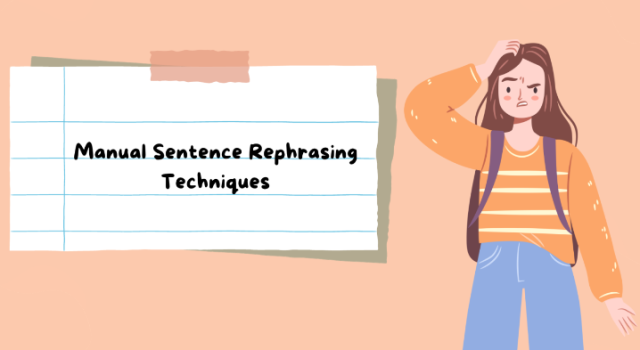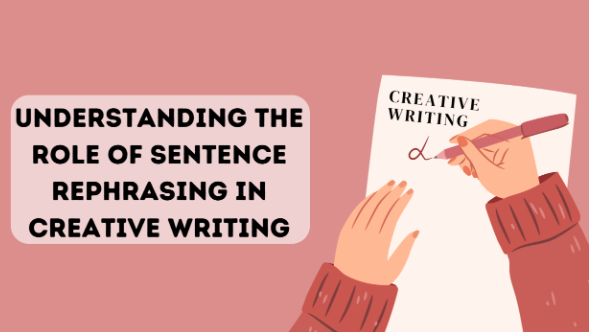Understanding Sentence Rephrasing in Creative Writing
Understanding sentence rephrasing in creative writing is an important skill for any creative writer to develop.
While the primary goal of creative writing is to tell a compelling story, understanding sentence rephrasing in creative writing, by using varied sentence structures and replacing repetitive words, keeps readers engaged. This is a unique skill that not all writers possess.
This article will explore the role that sentence rephrasing plays in creative writing and provide tips for effectively rephrasing sentences. By the end of this article, you will have a better understanding of sentence rephrasing and its role in creating writing.
What is Sentence Rephrasing?
Sentence rephrasing, also called sentence rewriting or sentence variation, is the process of restating a sentence using different words without changing its overall meaning. The goal is to convey the same information in a new way.
The new version of the text should be more readable, coherent, and streamlined so that readers don’t have complexity while understanding the rephrased text.
Sentence rephrasing is useful for avoiding redundancy and keeping the reader’s interest. It helps creative writing flow smoothly without jarring the reader with repetitive sentence patterns.
Online Tools for Sentence Rephrasing
Many free online sentence rephraser tools can assist writers in reworking sentences. Free rephrasing tools allow users to paste text and generate multiple rephrased versions with a single click. You can keep generating outputs until you get the right set of words.
Sentence rephrasing is like an art that makes writing better by changing how things are said. A sentence rephraser tool helps a lot by giving different ways to say something, making writing more interesting. It brings new ideas and makes stories deeper and more exciting, using different kinds of words and styles.
However, if you choose the right rephrasing tool, you will have a better output. Good tools are based on artificial intelligence and deep learning technologies to deeply examine the given material and then provide maliciously crafted output to satisfy your textual needs in the best way.
Make sure you carefully analyze the security, accuracy, and efficiency of an online sentence rephrasing tool before you give it a final go.

The Role of Sentence Rephrasing in Different Genres
Sentence rephrasing plays distinct roles across various creative writing genres:
- Poetry: Concise rephrasing allows fitting meaning into structured forms while using creative language. Economies words beautifully.
- Screenwriting: Dialogue is heavy, so rephrase “he said” verbs constantly for naturalism. Various action beats and scene descriptions.
- Journalism: Convey complex ideas using a range of sentence structures appropriate to the publication style.
- Fiction: Vary descriptions to avoid repetition as settings, characters, and plots unfold over many pages. Keeps the narrative moving?
- Blog Posts: Engage readers with varied, lively prose appropriate for the casual, conversational tone of blogs.
- Academic Writing: Formal style prioritizes concision and precision, using sophisticated sentence constructions to develop ideas fully.
Sentence rephrasing can play a pivotal role in many other genres. That means you can improve your writing across these genres and reap the maximum benefits. Good sentence rephrasing can be done through tried-and-true online sentence rephraser tools that offer accurate results quickly and efficiently. So, make sure you opt for the right tool before you start your paraphrasing quest.
Manual Sentence Rephrasing Techniques
For the most polished writing, creative authors develop their own sentence-rephrasing abilities. Those who also want to learn manual sentence rephrasing can take advantage of some of the best techniques. Here are some manual practices you can adopt:
- Substitute verbs with near-synonymous alternatives to differ descriptions of actions and states of being. Replace “said” verbs liberally throughout dialogue.
- Change the sentence structure by altering word order, adding or removing modifiers, or transforming clauses. For example, change an active to a passive voice construction, or vice versa.
- Replace nouns with synonyms to describe the same people, places, things, or ideas. Swap frequently used nouns for less common but appropriate alternatives.
- Try rephrasing around a different focus by emphasizing a new detail or perspective within the sentence. Highlight a new element of information.
- Condense or expand the sentence length by combining short sentences or splitting long, complex sentences into two. Vary sentence lengths for rhythm.
- Reposition sentence fragments or dependent and independent clauses to change word emphasis and flow.
Aside from the above-mentioned techniques, you can try other things that you think can work well to rephrase sentences in a better way. However, always make sure that the core intent of the message or context is not disturbed when you try to paraphrase sentences manually.
Mastering Sentence Rephrasing Skills
Developing strong sentence-rephrasing abilities requires regular practice. Not everyone can claim to have the best rewriting skills.
It takes time, and that’s why most people opt for reliable online sentence rephrasers. However, the following tips can help writers master sentence rephrasing techniques in no time:
- Set goals to rephrase sentences in all new writing.
- Identify repetitive patterns and consciously replace them with alternatives.
- Study published works in their chosen genre to absorb varied styles.
- Use rephrasing as an editing step to refine drafts before sharing writing.
- Solicit feedback from writing groups on where sentences could use refreshing.
Final thoughts on Understanding Sentence Rephrasing in Creative Writing
With diligent practice of rephrasing techniques, creative writers can produce prose that engages readers through varied yet natural-sounding sentence structures. Rephrasing prevents stagnation and keeps the reader turning pages.




